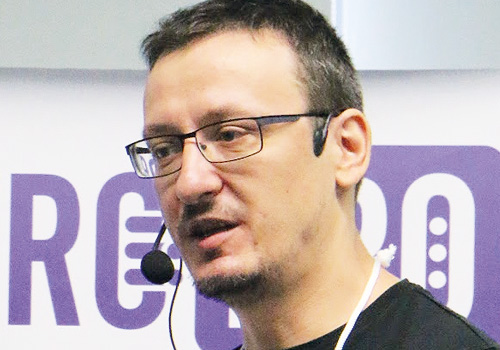Completed checklist Image via Shutterstock
In this interview, Viktor Farcic, a Senior Consultant at CloudBees, talks about his likes and dislikes about microservices. Here are his answers.
JAXenter: Why did you start using microservices?
Viktor Farcic: I started using microservices out of frustration. That frustration was generated from continuous failures to implement some of the practices I was proposing. We tried to have a good test coverage and failed. We attempted to implement continuous integration and, later on, continuous delivery, and failed. We sought to have short release cycles, and failed. We tried to create immutable deployment and failed. We decided to split the horizontal teams vertically and make them small and agile. That failed as well. In retrospect, the list of my failures is much bigger than the list of my successes. At one moment I realized that the root of the problems did not include development, testing, and release practices but architecture. The problem was in monolithic architecture. I won’t say that good development practices (for example XP) cannot be applied to monoliths. They can, but, more often than not, the results are sub-optimal. My switch to microservices was driven by the desire to implement better development practices.
JAXenter: What is the most important benefit of microservices?
Viktor Farcic: There are many so I’ll just name the first few that come to my mind. Innovation is probably at the top of my list of benefits. When you have a big monolithic application that was in development for a long time, changing it is a nightmare. Repercussions of a wrong decision can be so significant that many choose to stick with what they have. On the other hand, microservices allow us to change things fast and with a limited impact on the system as a whole. Shall we experiment with GoLang? Why not? Choose a small single service, rewrite it, and evaluate the result. If we are to develop a new feature as a new microservice, we might choose Node.js and MongoDB even though most of the system is written in Java and MariaDB. After all, if for a particular case Node.js seems like a better fit, why shouldn’t we go for it? Microservices allow us to change things and experiment with new languages and frameworks. Change is the major motor behind innovation and innovation is driving change. Monoliths are too big and often too coupled to allow such freedom.
I started using microservices out of frustration.
Other arguments in favor of microservices are the following: the ability to have small autonomous teams, the speed of delivery, true decoupling, scalability, fault tolerance, and so on.
JAXenter: Have microservices helped you achieve your goals?
Viktor Farcic: That depends on the point of view. In some projects microservices helped me accomplish my goals much faster, innovate, and apply XP practices. In others, rejection to move to microservices architecture helped me realize that it is time to move on, and switch to another company. I know that it might sound silly that one leaves a company because it develops monolithic applications. However, the problem lies beyond the types of applications. Usually such companies tend to have an organizational structure that is equally monolithic (inflexible, centralized, hierarchical, split horizontally, and so on). Monoliths are a reflection of the type of the organization that develops them.
Check out the full program of DevOpsCon
JAXenter: What do you think should be the optimal size of a microservice?
Viktor Farcic: I do not believe there is an answer to that question. There are cases when a microservice is not bigger than a hundred lines of code and others have thousands. Sure, a microservice is smaller than a monolith but it’s not the size that matters. What makes the difference is their decomposition and the size of the team that can maintain them. If what you developed is fulfilling a single purpose, can be managed by a single small team, is completely decoupled from other services, is self-sufficient, and it can be deployed independently from the rest of the system, then your microservice is just the right size. I’m trying to stay away from absolute statements. There is no formula that says microservices should be between X and Y lines of code.
JAXenter: What is the biggest challenge of microservices?
Viktor Farcic: The major challenge is best described through Conway’s Law. Monoliths are reflections of the organizations that created them. Switching to microservices architecture without changing organization will result in a failure. Ever since microservices became popular, everyone wants them, but only a few are willing to apply changes required for a successful transition. The fundamental challenge does not lie in technology but in culture. We can take a look at Linux, as the oldest example of a successful implementation of microservices model (at least the oldest I’m aware of).
Without Docker, containers are often too complicated to implement.
The whole OS is based on microservices. It consists of a vast number of small and autonomous programs (microservices) that have a clearly defined input and output (API). Most of those programs can be changed, updated, or replaced without bringing down the whole system. The complexity is accomplished through a combination of many small programs. Take a look at the organization behind it. It is open source. Chaotic (at first glance), decentralized, in most cases formed out of many small teams in charge of particular parts of the system. Now compare that with organizations behind monolithic applications. In most cases, you’ll notice that they appear less chaotic, that they are more centralized, and that they are made by much bigger teams which are often organized horizontally.
JAXenter: What technology do you think is the most important as far as microservices are concerned?
Viktor Farcic: The most important technology is, without a doubt, represented by containers. To be more precise, Docker. Containers are nothing new. They have a long history. However, without Docker, containers are often too complicated to implement. Without containers, microservices often produce more problems than value. Without self-sufficiency and immutability, microservices tend to produce too many, often conflicting, dependencies. Many people struggle with deployments of a single application. Deploying hundreds or even thousands of microservices exponentially multiplies the operational effort. Before Docker, the solution was to deploy each microservice as a separate VM. However, that creates additional cost in infrastructure since each VM carries additional overhead in resource usage. It is not a coincidence that the interest in microservices increased with the appearance of Docker.
JAXenter: How much do microservices influence an organization? Can they leave the organization unchanged?
Viktor Farcic: Adopting microservices must be followed by changes in the organization. These steps go hand in hand. Centralized organization with teams organized horizontally will fail to adopt microservices. With a risk of repeating myself, I will, again, quote Conway.
Organizations which design systems … are constrained to produce designs which are copies of the communication structures of these organizations.
M. Conway
JAXenter: When should you not use microservices?
Viktor Farcic: You should not use microservices when they do not bring additional value. There is no such thing as a one-size- fits-all solution. I cannot tell you a rule that states in which scenarios microservices are a good fit, and in which they aren’t. The decision depends on many factors such as maturity of the team(s), organizational structure, type of the application, and so on.
JAXenter: What are your guiding principles in the division of an application into microservices?
Viktor Farcic: The most important thing to understand when dividing an application into microservices is that the division should not be based on technology. Monolithic applications are divided into horizontal layers based on technological decisions. We have the data access layer separated from the business logic layer, that is split from the user interface layer, and so on. The primary way we were dividing applications in the past was based on technological decisions. Microservices divide the system horizontally. An application should be split into microservices based on functional criteria. It should be separated from the others vertically and communicate with the rest of the system through clearly defined APIs. Domain Drive Design is an excellent starting point when brainstorming how to split an application.
Check out Microservices Track at DevOpsCon
JAXenter: Should every microservice be written in the same language or is it possible to use more languages?
Viktor Farcic: I think the question is misplaced. One of the requirements of successful implementation of microservices architecture is to have small and autonomous teams in charge of the whole lifecycle of a microservice. If that team is truly independent, it will decide for itself in which language to write the microservice. That decision might coincide with the decisions made by other teams, or it may not. Many factors will influence those decisions. Are all developers proficient in only one language or are they multilingual? Ideally, we should pick the best tool for the job.
Microservices are much harder than they look and you are likely to make many mistakes.
One language might be more suited for system services while the other might shine as the weapon of choice for the backend. We might choose GoLang because of the size of its binaries and concurrency, Scala for its streaming capabilities, and JavaScript because of its dynamic nature. However, having the best tool for the job does not mean we know how to use it. Personally, I like diversity in almost anything, including programming. I do think that someone can be considered a good programmer without knowing how to code in multiple languages. On the other hand, every team is different, and we should leverage their existing skills. My suggestion is to give your teams as much autonomy as possible. Whether that will result in all services being written in the same language or each will be different is of lesser importance.
JAXenter: What aspects should you take into consideration before using microservices?
Viktor Farcic: Do not decide to go for the big bang approach. Do not try to change the whole monolith into microservices in one go. Microservices are much harder than they look and you are likely to make many mistakes. Start small, make mistakes, learn from them, improve, repeat. Do not expect to do it right from the first attempt. Embrace containers, form small autonomous teams, invest in DevOps practices, automate, automate, and automate.
Thank you very much!
Sessions & Workshops about Microservices at DevOpsCon
























































 6 months access to session recordings.
6 months access to session recordings.